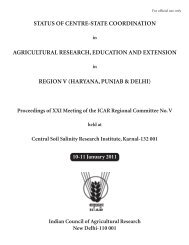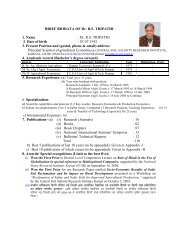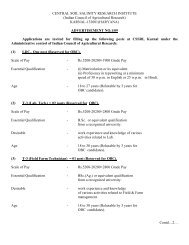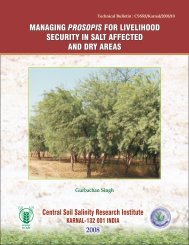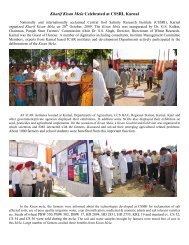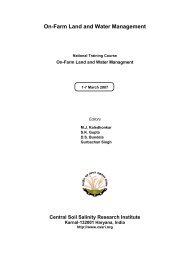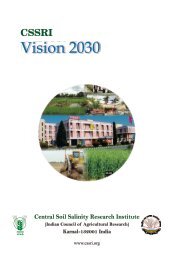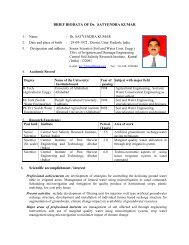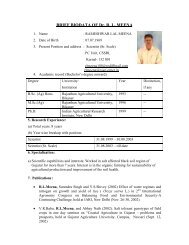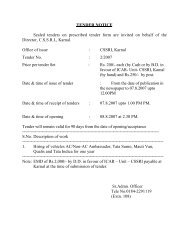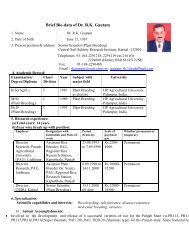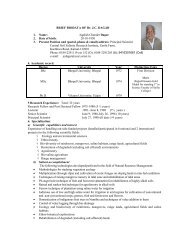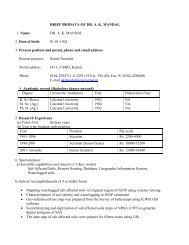BIOSAFOR - BIOSALINE (AGRO) FORESTRY - Central Soil Salinity ...
BIOSAFOR - BIOSALINE (AGRO) FORESTRY - Central Soil Salinity ...
BIOSAFOR - BIOSALINE (AGRO) FORESTRY - Central Soil Salinity ...
Create successful ePaper yourself
Turn your PDF publications into a flip-book with our unique Google optimized e-Paper software.
were also found tolerant to high sodicity with more than 70% survival rate but could not produce satisfactory<br />
biomass.<br />
Tamarix articulata ameliorated the soil by causing maximum reduction in pH and ESP in seven years and was<br />
followed by Prosopis juliflora and Acacia nilotica. Organic content in 0-15 cm layer increased from 0.05 to 0.28%<br />
under Tamarix articulata, from 0.04 to 0.30% under P. juliflora and from 0.02 to 0.14% under Acacia nilotica in 7<br />
years. The increase in organic carbon in the lower layers was, however lower.<br />
Air- dried aboveground biomass of different tree species estimated after 7 years<br />
of growth on highly sodic soil<br />
100<br />
90<br />
97.3<br />
80<br />
69.8<br />
Total Biomass (t/ha)<br />
70<br />
60<br />
50<br />
40<br />
30<br />
51.3<br />
20<br />
14.4<br />
10<br />
4<br />
2.7 1.8<br />
1.5 1.2 1.2<br />
0<br />
Ta An Pj Et Pd Ta Ds Cr Kp Pa<br />
Tree Species<br />
Fig. 6 : Air-dried above ground biomass (t/ha) of trees at Saraswati Range Forest site<br />
Ta= Tamarix articulata, An= Acacia nilotica, Pj=Prosopis juliflora, Et= Eucalyptus tereticornis, Pd=Pithecellobium dulce,<br />
Ta= Terminalia arjuna, Ds= Dalbergia sissoo, Cr= Cordia rothii, Kp= Kigellia pinnata, Pa= Parkinsonia acumilata<br />
Biomass of trees grown on a highly alkali soil at Shivri farm, Lucknow<br />
0<br />
These studies were carried out at Shivri farm located 20 km away from Lucknow, Uttar Pradesh (26 47' 58” N<br />
0<br />
and 80 46' 24” E) at an elevation of 100 m. The annual rainfall varies from 700 to 1000 mm (average 800 mm),<br />
0<br />
80% of which occurs during the months of July to September. The mean monthly temperature varies from 21<br />
0<br />
C in January to 40.5 C in June. The evaporation exceeds the rainfall for all the months except July and August.<br />
The ground water table fluctuates seasonally between 5-7 m.<br />
Examination of the profiles revealed that the soil as alkali in nature, fine loamy, mixed, hypothermic and<br />
classified as Sodic Ustochrept. The soil contained about 40 cm thick CaCO 3 concretion layer at about 80 to 120<br />
cm. At the time of planting, soil pH at the surface was 10.6 and ranged from 10.0 to 10.6 in different layers up<br />
to the depth of 1 m with ESP values of 89- 92.<br />
Six to nine months old seedlings of 10 multipurpose tree species were planted in auger holes (45 cm diameter<br />
at the surface and 20 cm at the bottom) 120 cm deep. Row to row and plant to plant distances were 4 m x 3 m.<br />
The auger holes were filled with a mixture of original soil, 4 kg Gypsum, 10 kg Farm Yard manure and 20 kg<br />
silt.<br />
Survival of Prosopis juliflora, Terminalia arjuna, Pongamia pinnata, Acacia nilotica, Casuarina equisetifolia and<br />
Pithocellobium dulce was > 95% after 10 years of planting. Maximum plant height after 10 years of planting was<br />
observed in Eucalyptus tereticornis followed by Casuarina equisetifolia and Prosopis juliflora. However,<br />
maximum diameter at breast height was recorded in Acacia nilotica, Eucalyptus tereticornis and Prosopis<br />
juliflora. These studies suggested that in addition to reclaiming these sodic soils, the tree-based systems also<br />
increased microbial biomass, microbial N and C in otherwise very low or dead mass of degraded sodic soils.<br />
17



